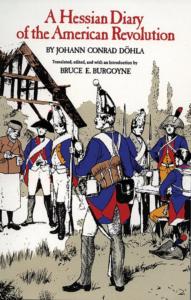In 1777, Johann Conrad Döhla journeyed from present-day Germany to fight alongside the British Army during the American War for Independence. He was one of the about 20,000 German-speaking troops, collectively referred to as “Hessians,” hired by King George III to help defeat the American Revolutionaries. Döhla fought from New York to Virginia and kept a diary. The following excerpt includes his entries during the month of July 1781, just before the surrender at Yorktown. Then the surviving Hessians surrenedered.
–Courtesy of the American Revolution Museum at Philadelphia
2 July. We were relieved during the morning by a command of Hessians.
6 July. During the evening Private [Johann] Bär, of Quesnoy’s Company, deserted from the camp without his uniform, dressed only in his linen blouse.
 8 July. During the afternoon the deserter Bär was returned to the regiment by the so-called Royal Refugees. They had captured him twenty miles from here.
8 July. During the afternoon the deserter Bär was returned to the regiment by the so-called Royal Refugees. They had captured him twenty miles from here.
10 July. The English fleet of transport and provisions ships, which had two warships and three frigates for an escort, was attacked by the French Admiral La Motte as the English were coming from Saint Eustatius in the West Indies en route back to England. One warship of seventy-four guns and two frigates and thirteen transport ships, carrying more than twenty-one hundred men, were captured. The rest were routed and, after a three-hour resistance, fled.
11 July. Punishment was carried out by the regiment. The deserter Bär, of Quesnoy’s Company, today ran a gauntlet of three hundred men with switches, twelve times.
12 July. Bär again had to run the gauntlet twelve times.
14 July. We received orders to embark.
15 July. We broke camp at five o’clock in the afternoon. We marched into New Portsmouth, to a wharf where the troops were to be embarked, but because it was too late, we spent the night lying under the open sky. I went on color guard.
To Chesapeake Bay
18 July. Our ships left the Portsmouth harbor and sailed to Chesapeake Bay, where we lay at anchor for ten days.
29 July. About ten o’clock in the morning, our fleet sailed out of the Chesapeake Bay.
31 July. We arrived in the sea harbor of the James River near Yorktown and dropped anchor.
This York is a small city of about three hundred houses, but with a large circumference. It lies close to the water of the James [sic] River, rather high up on sandy but level ground. It has three churches, two Reformed and one German Lutheran, without steeples, and two Quaker prayer houses, and a beautiful courthouse or city hall, which, like most of the houses, is built of brick. There are many house here that stand ruined and abandoned by their owners. An American occupation force of about three hundred militiamen was stationed here, which, however, on our arrival, pulled back to Williamsburg, sixteen miles from here, without firing a shot. We encountered few residents here, because most had gone farther inland with all their belongings; and therefore, no French foodstuffs were obtainable.
The harbor at Yorktown is deep and two English miles wide. The James River goes more than twenty miles farther inland, but beyond Yorktown it is navigable only by small ships.
A small island, several miles in circumference, named Gloucester, which has a few beautiful buildings, lies opposite York. During the past month of July there was such exceptional heat that it was nearly unbearable aboard ship.
Let’s Go Sail, Historically
Check rates and pick a day for a sailboat charter. and pick a day for a sailboat charter. See reviews on Trip Advisor.



